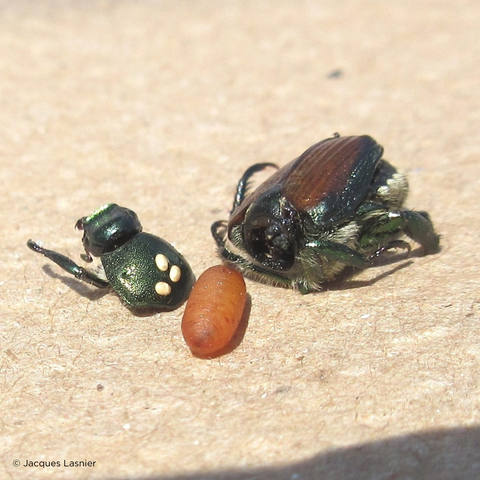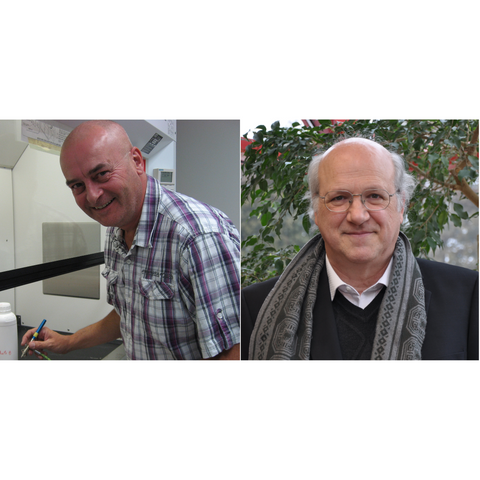Updated August 14, 2025 with our most recent research results
Do you see the white dots on the heads of Japanese beetles?
These are the eggs of a beneficial parasite: the tachinid fly Istocheta aldrichi. When the eggs hatch, the larvae feed on the beetle, naturally reducing its population and saving us the need for chemical treatments.
Since 2020, our strategy has been to better understand the behavior of this fly and create an environment favorable to its presence in our vineyards. Each year, we sow phacelia, which attracts Istocheta aldrichi thanks to its pollen, before it lays its eggs on the beetles.
🌱 A method at the heart of our sustainable viticulture: this approach is part of our commitment to protecting biodiversity and limiting the use of chemical inputs.

Phacelia is very beautiful and also very useful! It is an integral part of our sustainable farming methods.
LIFE CYCLE OF THE TACHINID FLY ISTOCHETA ALDRICHI
This fly, barely smaller than a housefly, emerges in its adult form from its pupa in late spring around mid-June. It feeds on nectar from the flowers in its habitat.

The Tachinidae fly Istocheta aldrichi.
Towards the end of June when the Japanese beetles emerge from the ground, this fly (I. aldrichi) begins laying its eggs just behind the head of the Japanese beetles (on the prothorax, pronotum) until the beginning of August.

Two Japanese beetles in the Vineyard on which we can see several Tachinidae fly eggs (white dots).
The egg hatches shortly after being laid. The larva enters the Japanese beetle and feeds on its interior (parasitism). Within a few days (about 5 days), the Japanese beetle dies. The fully mature larva forms its pupa in just a few hours.


The larval stage on the left, then the pupal stage on the right. The pupa is the intermediate stage between the larval and adult fly stages.
The pupa will remain inside the Japanese beetle's shell (mummy) until the following spring when it emerges as an adult (fly). Then, it will begin its life cycle again.

The egg hatches and the larva enters the Japanese beetle where it will remain until the following spring in the pupal stage.
__________________
SUMMARY OF SCIENTIFIC RESEARCH CONDUCTED AT L'ORPAILLEUR (2019-2023)
In collaboration with Ag-Cord Inc., Charles Vincent and Plant Select, we conducted rigorous scientific monitoring over five years to measure:
- The abundance of the Japanese beetle (Popillia japonica) on our Vidal and Seyval Blanc grape varieties.
- The rate of parasitism by Istocheta aldrichi.
- Key dates of fly emergence and phenological stages of the vine.
Key results:
Between 2019 and 2023, the number of beetles observed in the monitored plots fell significantly (from more than 1900 to around 500 individuals per grape variety).
Over the same period, the percentage of beetles carrying at least one Istocheta aldrichi egg increased from less than 10% to more than 40%.
After about 9 years in the vineyard, I. aldrichi has helped restore a natural balance, making any insecticide treatment against the Japanese beetle unnecessary.
📄 To read the full study published in the Bulletin of Insectology: Abundance of Japanese beetle adults and its parasitoid Istocheta aldrichi in a Quebec commercial vineyard
_________________
BALANCE ACHIEVED IN THE VINEYARD BETWEEN PEST AND PARASITE
Since 2014, Tachinidae fly populations have increased exponentially in the vineyard, which has contributed to the significant reduction in Japanese beetle populations. We are seeing a balance between the pest and its parasite currently being achieved at the Orpailleur Vineyard.

|
THE FRUITS OF OUR 25 YEARS OF RESEARCH AND DEVELOPMENT WITH AG-CORD AND CHARLES VINCENT. Charles Vincent worked from 1983 to August 2021 as an agricultural entomology researcher for Agriculture and Agri-Food Canada's Horticultural Research and Development Centre in Saint-Jean-sur-Richelieu, QC. In this capacity, he collaborated for 25 years with l'Orpailleur and Co-Lab R&D. He is currently a scientific consultant, notably in writing popular agricultural texts and producing podcasts related to agriculture and the environment.
|










































